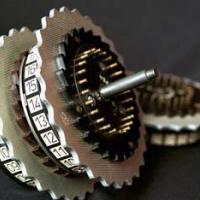
The rail fence cipher

The Enigma machine was used by the Germans to encode messages in WW2.
Let's get codebreaking.
The rail fence cipher involves writing messages so that alternate letters are written on separate upper and lower lines. To create the final encrypted message, the sequence of letters on the upper line is then followed by the sequence on the lower line. The code maker improves the security of the cipher by choosing more than two lines to encrypt the message.
Take the plaintext "pancakes for breakfast" for example. It can be enciphered using a shift of two by writing it as follows:
| p | n | a | e | f | r | r | a | f | s | ||||||||||
| a | c | k | s | o | b | e | k | a | t |
The ciphertext is then created by reading across the rows as follows:
pnaefrra fsa cksobekat
In this case, a shift of two, in other words two lines, was used. In order to decipher it, the ciphertext must be split into two parts. If the shift was three, then the ciphertext must be split into three lines, four lines for a shift of four etc.
Here is your cypher text. You'll have to work out for yourself which shift was used. Happy puzzling!
TURNITYLNTHASMTITLRBAQEC.SONEASEBEWBMSASEB'BNODOENNIVH
MTTXRBLTIELTBHSAIOUSUWHITNURTQZEEOEBANODISEBLIMTTTXEEBW
YIURI.SSLNEANPNMTAAHITHLMTIUETNCNENULRCCCEVNOHWYMSNEESS
LIAITMEURT'ADEHSRISIEYBHSEDWTUURDNVUKUASENRAESO.
You can find out more about the rail fence cypher on Simon Singh's website.
If you are stumped by last issue's puzzle, here is the solution.
For some challenging mathematical puzzles, see the NRICH puzzles from this month or last month.